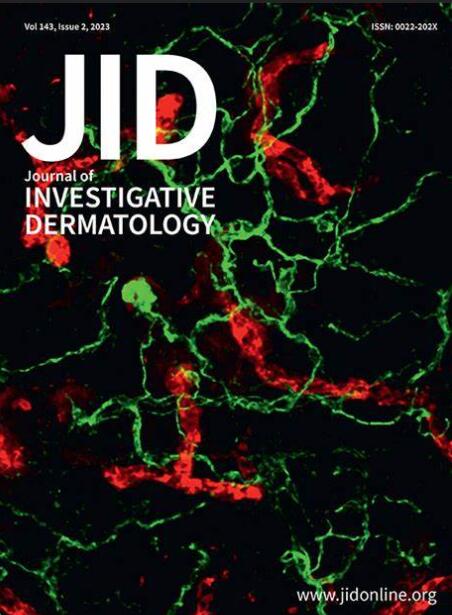Desmosomal Hyper-Adhesion Affects Direct Inhibition of Desmoglein Interactions in Pemphigus
IF 5.7
2区 医学
Q1 DERMATOLOGY
引用次数: 0
Abstract
During differentiation, keratinocytes acquire a strong, hyper-adhesive state, where desmosomal cadherins interact calcium ion independently. Previous data indicate that hyper-adhesion protects keratinocytes from pemphigus vulgaris autoantibody–induced loss of intercellular adhesion, although the underlying mechanism remains to be elucidated. Thus, in this study, we investigated the effect of hyper-adhesion on pemphigus vulgaris autoantibody–induced direct inhibition of desmoglein (DSG) 3 interactions by atomic force microscopy. Hyper-adhesion abolished loss of intercellular adhesion and corresponding morphological changes of all pathogenic antibodies used. Pemphigus autoantibodies putatively targeting several parts of the DSG3 extracellular domain and 2G4, targeting a membrane-proximal domain of DSG3, induced direct inhibition of DSG3 interactions only in non-hyper-adhesive keratinocytes. In contrast, AK23, targeting the N-terminal extracellular domain 1 of DSG3, caused direct inhibition under both adhesive states. However, antibody binding to desmosomal cadherins was not different between the distinct pathogenic antibodies used and was not changed during acquisition of hyper-adhesion. In addition, heterophilic DSC3–DSG3 and DSG2–DSG3 interactions did not cause reduced susceptibility to direct inhibition under hyper-adhesive condition in wild-type keratinocytes. Taken together, the data suggest that hyper-adhesion reduces susceptibility to autoantibody-induced direct inhibition in dependency on autoantibody-targeted extracellular domain but also demonstrate that further mechanisms are required for the protective effect of desmosomal hyper-adhesion in pemphigus vulgaris.
在丘疹性荨麻疹中,脱丝体过度粘附会影响对脱丝蛋白相互作用的直接抑制。
在分化过程中,角朊细胞会获得一种强大的超粘附状态,在这种状态下,脱膜粘附蛋白的相互作用与 Ca2+ 无关。以前的数据表明,超粘附能保护角质形成细胞免受天疱疮自身抗体(PV-IgG)诱导的细胞间粘附力丧失的影响,但其基本机制仍有待阐明。因此,我们在此通过原子力显微镜研究了超粘附对 PV-IgG 诱导的直接抑制去疱疹素(Dsg)3 相互作用的影响。超粘附消除了细胞间粘附的丧失以及所有致病抗体的相应形态学变化。丘疹性荨麻疹自身抗体假定靶向Dsg3胞外结构域(ECD)的几个部分,而2G4则靶向Dsg3的膜近端结构域,这两种抗体只在非超粘附角质形成细胞中直接抑制Dsg3的相互作用。相反,靶向 Dsg3 N 端 ECD1 的 AK23 在两种粘附状态下都能直接抑制 Dsg3 的相互作用。然而,不同的致病抗体与脱丝体粘附蛋白的结合并无不同,在获得超粘附时也没有变化。此外,嗜异性的 Dsc3-Dsg3 和 Dsg2-Dsg3 相互作用不会导致 wt 角质细胞在高粘附状态下对直接抑制的敏感性降低。总之,这些数据表明,在依赖自身抗体靶向 ECD 的情况下,超粘附会降低对自身抗体诱导的直接抑制的敏感性,但同时也表明,脱粘体超粘附在 PV 中的保护作用还需要进一步的机制。
本文章由计算机程序翻译,如有差异,请以英文原文为准。
求助全文
约1分钟内获得全文
求助全文
来源期刊
CiteScore
8.70
自引率
4.60%
发文量
1610
审稿时长
2 months
期刊介绍:
Journal of Investigative Dermatology (JID) publishes reports describing original research on all aspects of cutaneous biology and skin disease. Topics include biochemistry, biophysics, carcinogenesis, cell regulation, clinical research, development, embryology, epidemiology and other population-based research, extracellular matrix, genetics, immunology, melanocyte biology, microbiology, molecular and cell biology, pathology, percutaneous absorption, pharmacology, photobiology, physiology, skin structure, and wound healing

 求助内容:
求助内容: 应助结果提醒方式:
应助结果提醒方式:


